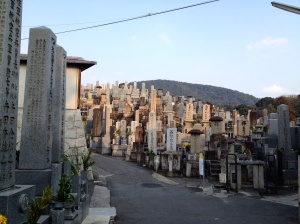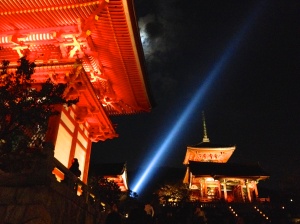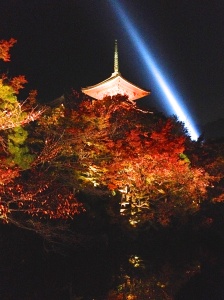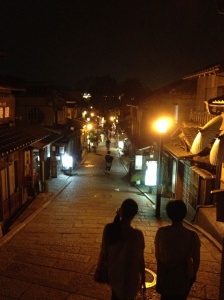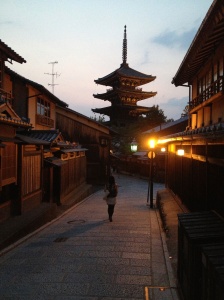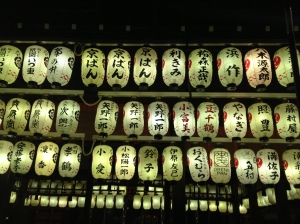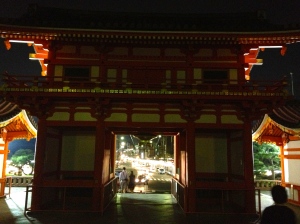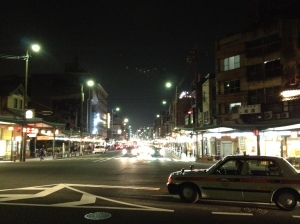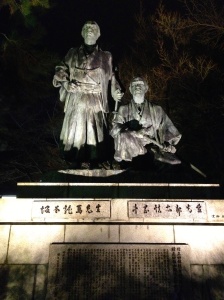I live in the future. First of all, I’m 16 hours ahead of most people reading this. You guys are way behind. Secondly, have you ever considered what it means to be alive in 2014? That’s a really big number. The third reason, however, is the most interesting to me, and also the most complicated. Rather than trying to explain it to you, I’d like to show you.
So let’s go for my favorite tour in Kyoto. I’d say it’s imaginary, but the imagining is only on your end. This is a real tour, and my favorite place to take all my visitors. But because our tour will take place in your head, I’m going to take some creative liberties with the concept of time. This is my pioneering attempt at weaving tapestries – not with threads of fabric, but threads of vivid memories from this enchanting place. So, are you ready? Ikimashou! (Let’s go!)
大昔– ancient times
The late afternoon air is thick and muggy as we exit the train station, with ripe clouds swelling the skies. “It’s about 15 minutes east of here”. Taxis and busses rush past us as we cross a beautiful bridge. “Kyoto is pretty rad,” I begin. “It’s where traditional Japan is still alive. I heard this bridge was the sight of an important samurai battle like several hundred years ago…”
As we approach the mountains we enter the southern boundary of the legendary Gion district. Ahead of us is one of Kyoto’s thousand-something temples. “This way.” We take a narrow road running eastward along the temple wall into the rising hills. After a bit of climbing the view opens up to reveal our location. A massive graveyard sprawls ahead of us, swallowing our speech like the granite stones swallow our path. We press on through the heavy silence of the dead, weaving uphill among epitaphs of cremated ancients. “I wonder how old these are…” The whispered thought is swept away by the chilly breeze at our necks.
By the end of the graveyard path, there’s no debate about whose world we now walk in, as the sun’s last light falls on our modern society somewhere out West. “So this is Kiyomizu-dera.” Welcome to ancient Kyoto.
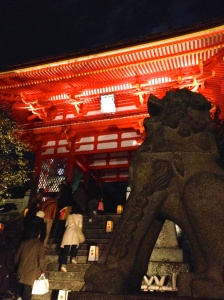 stone guardian of Kiyomizu-dera
stone guardian of Kiyomizu-dera
We ascend the stone stairs under the grimacing supervision of a stone lion, passing through the first ornately orange gate. Ahead, several structures come into view. “I call this one the mothership.” On que, a brilliant spotlight bursts forth from the shadowy hills, piercing the dark sky above the stunning orange architecture of the historic building. The light-up has begun.
“Waaa! Kireinaa!” The excited voices of a kimono-clad group of girls free our eyes from the captivating lights. Still speechless, we follow them as they shuffle on toward a hallway dimly lit by a dangling row of golden lanterns. We slowly pass through to join the gathering crowd on a giant wooden balcony. Leaning over the smoothly polished railing, we watch the ant-trail of visitors scurrying down the mountain some 50 feet below us. We trickle off into the stream of people flowing from the balcony to the steep mountainside path for Kiyomizu’s most celebrated view. In the foreground, the beautifully lit main structure squirms and sparkles with excited tourists and their cameras. In the background, the shimmering city of Kyoto gently laps against its mountain banks like a lake of pale light, rippling about the central lighthouse of Kyoto Tower. We struggle to connect words that could articulate the peculiar yet beautiful juxtaposition of these two legendary buildings of different centuries. Stunning.
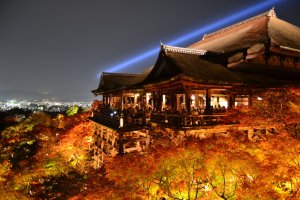 Kiyomizu in it’s autumn robe – photo cred: Google
Kiyomizu in it’s autumn robe – photo cred: Google
We join the ant-flow as it weaves an ancient forest to the lower grounds of the temple complex. The sound of trickling water is accompanied by the appearance of an iron dragon. A line of Japanese with long bamboo ladles gather to capture the treasured waters flowing from its lips. We carry on along a still pond, looking back to see the dazzling evening splendor of Kiyomizu reflected in the dark water.
The crowd thickens as we spill into the main street. Flanking the narrow stone pavement are an array of bustling stores, selling all kinds of traditional gems from hand-crafted fans to beautiful tapestries. “Irasshaimase douzo!” The calls of merchants and the aroma of roasting tealeaves fill the air. As the crowd gently pushes us along, we happily grab our fill of free mochi samples from the smiling women in their storefronts. “This way!” We escape the flow of pedestrians for a narrow, easily missed staircase descending to a smaller, quieter path of stone lined with more traditional wooden shops. Into the belly of Gion.
Finally the clouds give way. The gentle pattering of raindrops on our umbrellas nearly disguises another peculiar sound echoing around the bend. The rapid “clop-clop” of wooden sandals on stone precedes two women in stunning silk kimonos. Beneath bamboo umbrellas dripping with rain, a pair deep red lips painted on white faces peek out as they pass us by. “Geisha!” we whisper in fascination. Like phantoms, the shuffling of their feet quickly vanishes down a narrow alleyway, and only the gentle pattering of the rain remains. Slightly swaying lanterns bounce their soft light off puddles in the whispering street. We carry on.
After a few more turns, climbs, and descents through mysterious streets, we find another brilliantly orange tori gate. I have to duck below the giant golden lantern suspended at the entrance. The temple grounds expand before us, centered about an ancient wooden stage donning an impressive display of white and red paper lanterns. “This place was built almost 1300 years ago…”
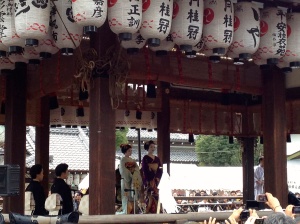 maiko-san (geisha-trainees) taking the stage at Yasaka-jinja
maiko-san (geisha-trainees) taking the stage at Yasaka-jinja
We wander on before coming to a surprised halt beneath the orange crossbeams of Yasaka-jinja’s main entrance – the gate between worlds. Behind us is the world of rickshaws, paper lanterns, and wooden sandals. Before us, hustling forward in dazzling light toward the heart of the city is Shijo-dori – one of Kyoto’s busiest urban streets. As we descend the stone stairs toward the pavement, each step takes us 100 years forward – into the world of taxi-cabs, streetlights, and high heels.
“I’m hungry, you wanna get some conveyor belt sushi? I’ll see what my friends are up to.” I pull out my phone and send out a dinner invitation before opening Google maps to re-navigate. We’re back in our world.
将来 – the future
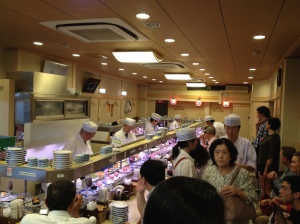 kaiten (conveyer belt) sushi in Kyoto
kaiten (conveyer belt) sushi in Kyoto
To us, it’s the past that seems exotic – the paper lanterns, the geishas on wooden sandals, the dragon-shaped fountains. However, in the biography of this city, this has been much more the norm. It wasn’t until about 150 years ago, a mere fraction of the city’s lifetime, that things really began to change in Kyoto. Now is the future. The taxis and trains. The stilettoes and sunglasses. The iPhone cameras and instant messaging. I am the future. The tall blonde guy biking around on Saturdays. The tall blonde guy speaking a different language at school. The tall blonde guy with headphones in on the subway. Perhaps it’s me that’s exotic. It’s a peculiar life I’m living after all – a native of Southern California, with European ancestry, now living in the ancient capital of the Land of the Rising Sun. But the ancient times are no more. Places like Kyoto’s Gion district are a remnant of a world that once was – the living saga of a temporal diaspora. Now is the future. I live in the future.


